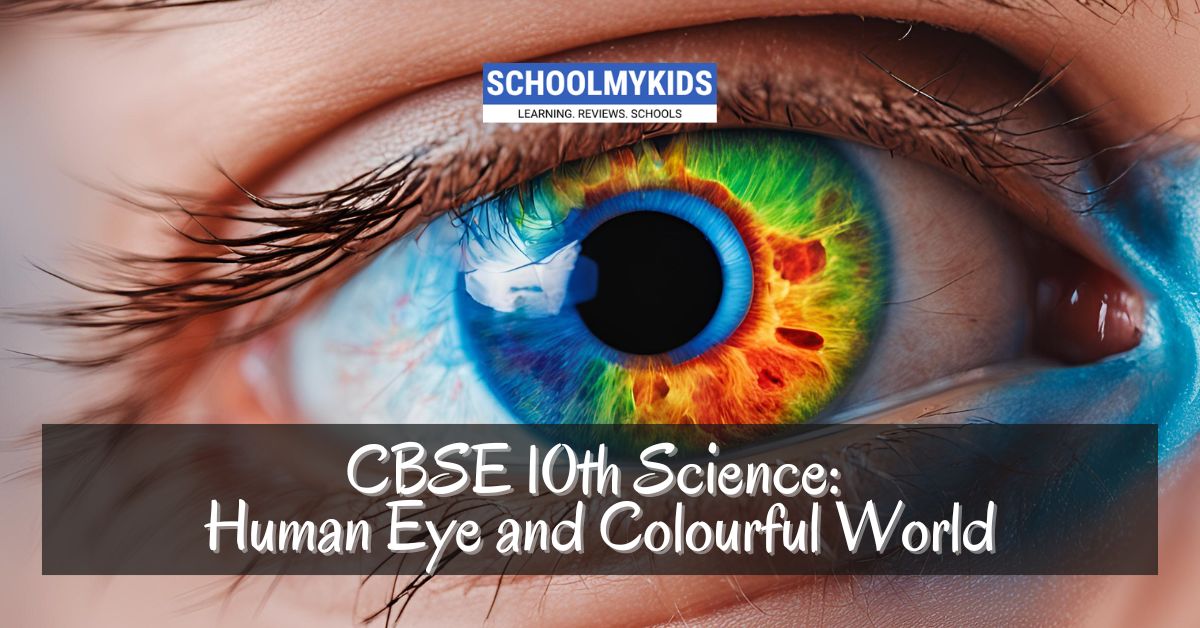Summary
The chapter “The Human Eye and the Colourful World” in Class 10 Science explores the structure and functioning of the human eye, the phenomenon of vision, and the interplay of light and colors. It delves into how we perceive colors, the defects of vision, and their corrections. The chapter also covers optical phenomena in nature, such as the formation of rainbows, scattering of light, and atmospheric refraction.
Analysis
Understanding the human eye and optical phenomena enriches our knowledge of vision and light. This chapter provides insight into the biological and physical principles that enable sight and color perception. It highlights the complexity of the eye, the intricacies of light behavior, and the science behind everyday visual experiences. The study of vision defects and their corrections underscores the advancements in optical health, while the exploration of natural optical phenomena fosters a deeper appreciation of nature.
Key Concepts in The Human Eye and the Colourful World
- Structure of the Human Eye:
- The human eye consists of parts like the cornea, iris, pupil, lens, retina, and optic nerve.
- The cornea refracts light, the iris controls the pupil size, the lens focuses light, and the retina detects light and converts it into signals sent to the brain.
- Functioning of the Eye:
- Light enters the eye through the cornea, passes through the aqueous humor, pupil, lens, and vitreous humor, and finally hits the retina.
- The retina contains photoreceptor cells (rods and cones) that detect light and color.
- Vision Defects and Corrections:
- Myopia (Nearsightedness): Difficulty in seeing distant objects, corrected with concave lenses.
- Hypermetropia (Farsightedness): Difficulty in seeing close objects, corrected with convex lenses.
- Presbyopia: Age-related farsightedness, corrected with bifocal lenses.
- Astigmatism: Blurred vision due to irregular curvature of the cornea or lens, corrected with cylindrical lenses.
- Color Vision and Perception:
- Cones in the retina are responsible for color vision.
- The primary colors of light are red, green, and blue, which combine to form other colors.
- Natural Optical Phenomena:
- Dispersion of Light: Splitting of white light into its component colors by a prism.
- Formation of a Rainbow: Caused by the dispersion of sunlight by raindrops, resulting in a spectrum of colors.
- Scattering of Light: Shorter wavelengths of light (blue) scatter more than longer wavelengths (red), causing the sky to appear blue and sunsets to appear red.
- Atmospheric Refraction: Bending of light as it passes through different layers of the atmosphere, leading to phenomena like the apparent shift in the position of stars.
Practical Applications
- Corrective Lenses:
- Use of spectacles or contact lenses to correct vision defects.
- Optical Instruments:
- Use of microscopes, telescopes, and cameras that utilize principles of light refraction and reflection.
- Understanding Natural Phenomena:
- Explaining rainbows, the color of the sky, and the appearance of stars using principles of light behavior.
- Optical Health:
- Regular eye check-ups and understanding the importance of eye care.
20 Questions with Answers
- What is the function of the cornea?
- The cornea refracts and focuses light entering the eye.
- How does the iris control the amount of light entering the eye?
- The iris adjusts the size of the pupil to control the amount of light entering the eye.
- What is the role of the lens in the eye?
- The lens focuses light onto the retina.
- What are the photoreceptor cells in the retina called?
- The photoreceptor cells are called rods and cones.
- What is myopia and how is it corrected?
- Myopia is nearsightedness, corrected with concave lenses.
- What is hypermetropia and how is it corrected?
- Hypermetropia is farsightedness, corrected with convex lenses.
- What causes presbyopia?
- Presbyopia is caused by the loss of elasticity of the eye lens with age.
- What is astigmatism and how is it corrected?
- Astigmatism is blurred vision due to irregular curvature of the cornea or lens, corrected with cylindrical lenses.
- What is the function of cones in the retina?
- Cones are responsible for color vision.
- What are the primary colors of light?
- The primary colors of light are red, green, and blue.
- Explain the dispersion of light.
- Dispersion of light is the splitting of white light into its component colors by a prism.
- How is a rainbow formed?
- A rainbow is formed by the dispersion of sunlight by raindrops, resulting in a spectrum of colors.
- Why does the sky appear blue?
- The sky appears blue due to the scattering of shorter wavelengths of light (blue) by the atmosphere.
- Why do sunsets appear red?
- Sunsets appear red because the light must pass through more of the Earth’s atmosphere, scattering shorter wavelengths and leaving longer wavelengths (red).
- What is atmospheric refraction?
- Atmospheric refraction is the bending of light as it passes through different layers of the atmosphere.
- How is a star’s apparent position affected by atmospheric refraction?
- Atmospheric refraction causes stars to appear slightly shifted from their true positions.
- What causes the twinkling of stars?
- The twinkling of stars is caused by the continuous refraction of their light by the Earth’s turbulent atmosphere.
- What is the blind spot in the eye?
- The blind spot is the point on the retina where the optic nerve exits the eye, lacking photoreceptor cells.
- What is the significance of regular eye check-ups?
- Regular eye check-ups help detect and correct vision problems early, ensuring optimal eye health.
- How do bifocal lenses help with presbyopia?
- Bifocal lenses have two different optical powers to correct both near and distant vision problems caused by presbyopia.
Understanding the human eye and the colorful world enriches our knowledge of vision and light, enabling us to appreciate the complexities of sight and the beauty of optical phenomena in nature.








Be the first one to comment on this story.